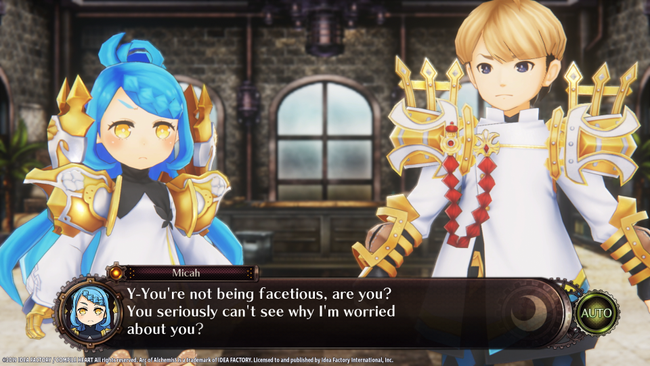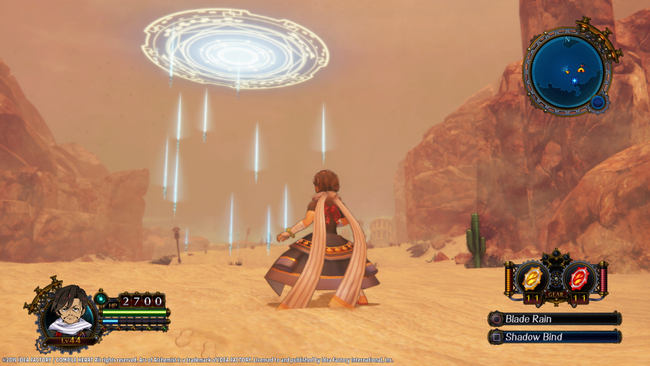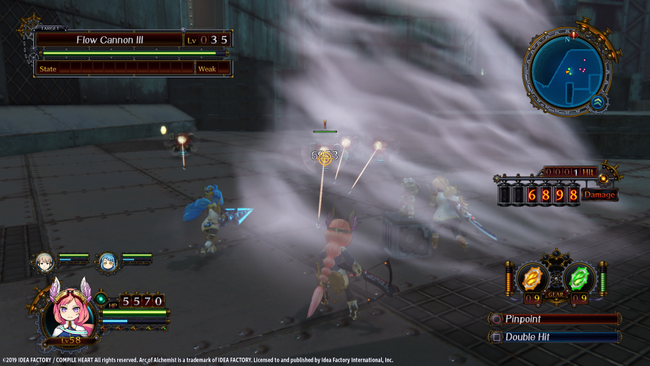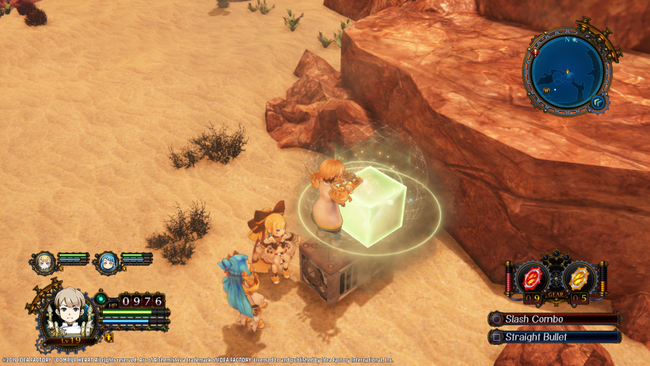Arc of Alchemist Review
While I absolutely regret ever having volunteered to review this game, I probably needed an experience like Arc of Alchemist to remember that maybe, sometimes, there's a good reason that some games will bomb in Japan. The little of what I'd seen about the game leading up to its launch seemed interesting enough - exploration, including sections where you're forced to set lights in order to see your surroundings, is something I've liked as an idea since Dark Souls 2 was first revealed. The story's concept, while nothing groundbreaking, seemed like it might hold some promise.
I'm pretty sure the only positive thing that I can say about Arc of Alchemist is that I didn't run into any bugs during my playthrough. The largest complaint I have is that I didn't find a game-breaking bug to give me an excuse to quit the game while I was ahead.
Frankly, I don't know where to start here. My experience with this game is like I'm examining a corpse, but between all the would-be fatal wounds I can't actually discern what was the leading factor in the title's mutilation. The game's story and the pacing are all over the place - key pieces of the plot feel like they're missing. You start the game with the majority of your party already in tow, and the game makes very little effort to treat your companions as actual characters. Rather, you're drip-fed information about your companions through random skits whenever you head back to town in-between expeditions.

This was a horrible idea for a number of reasons. Namely that it means that - whenever you go back to base, whether it might be to just upgrade your town or to buy new equipment, you're immediately ambushed with scenes that have absolutely nothing to do with the plot. If you actively want to see these scenes, to get as much information about your party members as possible, you have to jump into an expedition and right back to the base for every scene in the game. I don't know how many the game has in total - I didn't return to base except when it was absolutely necessary - but for both players that want to get as much out of the story as possible, as well as those that want to focus on the gameplay first and foremost, this system is a mess.
Character progression, similarly, makes absolutely no sense. To understand why, however, requires a brief explanation of the game's combat. You have a variety of weapon types that you can equip to your characters, and depending on the weapon class, your moveset changes. In the end, the combat boils down to spamming a single button for melee, but at the very least, moves themselves are different comparing something like a dagger and a staff. What doesn't make sense is how the game's ranged attack doesn't depend on the weapon class, but rather the specific weapon that you're using. As far as I can tell, if you like the ranged attack on a previous weapon, you're out of luck when it comes time to upgrade your weapons to the next tier.
In what can only be called extreme irony, coincidentally the penultimate weapon for the sword class has a ranged attack that sends out tons of projectiles at once which will absolutely tank the framerate on Switch. Since enemies have differing melee and ranged attack defenses, there will inevitably be monsters later on in the game where you'll be forced to use the performance-tanking ranged attack quite a bit to defeat them. I don't know if the other weapon classes are any better in that regard - but considering everything else about the game, I wouldn't be surprised if that were the case.

Making character progression even more confusing, is how you gain access to stronger weapons and armor in the first place. Arc of Alchemists' home base has a base-building mechanic, where you'll have a set number of tiles surrounding your unnamed country's center. In order to populate shops with new items, you first need to invest in new buildings. Some allow you to further train your characters (with stronger abilities, for example). Some will increase the highest level of armor that will be available to you in the shop. Likewise for stuff like weapons and accessories.
Each of these buildings that you invest in you'll have to set on the map somewhere, and every so often you'll also have to expand the scope of your kingdom to accommodate more structures. I can't help but feel like the whole system is 3 steps too many. Buildings themselves require specific materials either found lying around in the game world or dropped by enemies. It's impossible to discard the feeling that it would've made a lot more sense to use the materials to craft weapons and armor directly, as the base-building feel solely like needless padding. As far as I could tell, deciding where to place buildings did not matter much, if at all, and only works as an extra needless hurdle in upgrading your characters' equipment.
Taken in the context of the game as a whole, it's easy to come to the assumption that all of this padding was explicitly done to make the game appear longer than it actually is. Each of the game's areas isn't all that big - you'll finish most of them in under an hour, even with exploring the nooks and crannies - and there's only 5 of them in total. I finished the game with 6 hours on the clock, and I'm sure that at least 1 of those hours was digging around in menus. Every single one of the game's locales is a desert (barring one exception at the very end of the game), with the main difference between each of them being color grading. The level design also differs a little bit, but as each area grows in size and scope the performance drops at an inversely proportional rate.

I have been told that the game performs poorly on PlayStation 4, but having played the game on Switch myself and then comparing it to footage somebody else captured of the PS4 version on Youtube, it's still a night and day difference between the two platforms. You shouldn't buy Arc of Alchemist under any circumstance, but that goes double for the Switch release. I would argue that the game is essentially unplayable in handheld mode and that it's only slightly better in docked mode. You *can* finish the game on Switch, as I did, but please take my word for it when I say that I regret this decision of mine to soldier through this interactive slideshow more than any words could accurately express.
Which brings me to the review score. This will, undoubtedly, be a point of contention - but hear me out. This game is $40 on the Nintendo eShop, and while you could technically finish the game on a Switch Lite, the performance would likely never exceed 20FPS at the best of times, and would regularly dip to 10~ FPS whenever anything particularly demanding would hit the screen. Docked mode was already barely playable, and I feel like I'm going easy on the game's performance by even insinuating that another human being could potentially subject themselves to this disaster of a port.
A little word about level design, as it is very much relevant to the discussion of the game's abysmal performance - part of the game's whole shtick is how you can use the main character, Quinn's, equipment - the Lunagear - to attack enemies and solve puzzles. There's a somewhat unique mechanic where you can combine two of the "elemental orbs" that you've collected to make unique attacks, like attack sentries, a sonar to search for treasure, or more. However, any of the effect heavy versions of these also tank the framerate. Set down some healing totems and watch the already shaky FPS halve itself - now try and fight enemies in that mess.

One use of the Lunagear's Earth Orb is its ability to make boxes. Multiple times, the game will ask you to find an area where you can manually make a staircase out of these boxes, one box at a time, and then climb the stairs to a ledge in order to progress further on in the level. Making the stairs is tedious and bad enough - climbing them is even worse, particularly when the framerate is concerned. I cannot stress enough that these boxes are barely as large as the main character model, and moving while jumping in this game is extremely finicky at the best of times. There was one section where I had to keep retrying to climb a makeshift staircase for at least 5 minutes because the framerate would constantly make me overshoot the steps and fall back down.
Elsewhere, in the final dungeon no less, you're tasked with lighting some lamps to unlock a door. You have to light 12 of them, which would appear to be a cheeky way of trying to make sure that you've leveled up enough to have the full 12 charges for your Lunagear, but more than that - the framerate kept dipping the more of each lamp that I lit, and by the time all of them had been ignited I'm pretty sure I could have actually counted the framerate without much effort. I didn't bother to check how bad that section was in handheld mode - I don't want to know, honestly.
While Arc of Alchemist performs poorly on Nintendo Switch in any mode, there are over 5 million Switch owners out there that could, potentially, buy this game and be stuck with handheld mode performance. Poor performance is bad enough, but let me put it as simply as possible - the port in this state should not have been allowed to release. It's an embarrassment and Idea Factory clearly knew what a stinker the game was with the haphazard axing of the game's originally planned English dub and NA physical releases. Arc of Alchemist is the worst game that I have ever reviewed, and I sincerely hope that Idea Factory takes the time to really consider how this game came out the way that it did. I know they can do better than this.